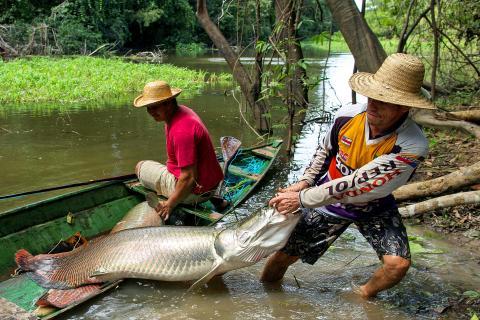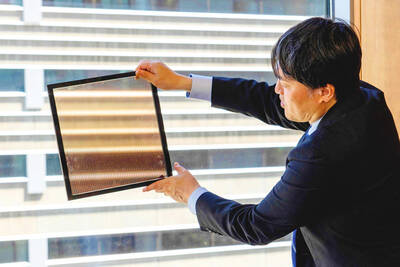Its white flesh is tender and tasty, it can measure up to 3m long and weigh more than 200kg: Meet the pirarucu, one of the world’s largest freshwater fish that is native to the Amazon.
The enormous animal, once threatened with extinction, is now on dinner plates in Rio de Janeiro’s fanciest restaurants, thanks to a number of chefs who have championed the delicacy and the indigenous communities who ensure its continued survival.
“Without them, there would be nothing left,” said Frederic Monnier, the head chef at the city’s hip Brasserie Rosario.

Photo: Reuters
“What they’re doing for the Amazon is priceless,” added Jessica Trindade, the Brazilian chef at Chez Claude, an institution in the city’s restaurant scene.
Chef Marcelo Barcellos uses pirarucu in his moqueca, a fish stew swimming in palm oil and seasoned with coriander that is a signature Brazilian dish originating in the northeastern state of Bahia.
Served with a toasted cassava flour mixture and nuts that come straight from the Amazon basin, the moqueca delights foodies’ taste buds and eyes, as the white fish contrasts with the yellow flour and green spices.
The taste is akin to that of other saltwater whitefish like pollock or cod.
Barcellos, the executive chef and owner of the restaurant Barsa, is one of several Rio de Janeiro chefs who have happily added pirarucu to his menu.
However, not that long ago, before pirarucu made it to the top tables in the “Marvelous City,” Arapaima gigas — or Amazonian cod, as it is sometimes called — almost vanished from menus.
It was brought back from the brink of extinction thanks to the establishment at a nature preserve of a sustainable fishing program with strict quotas. Pirarucu can only be fished from July to November, the non-mating season.
Raising the pirarucu’s profile with Rio de Janeiro’s top chefs has certainly helped.
The Taste of the Amazon project has helped do that. Recently, nine chefs traveled to northern Brazil to observe how the Paumari community has established sustainable practices for harvesting pirarucu.
Through their contact with the indigenous fishermen, the chefs learned which parts of the fish are the best. That knowledge ended up on their menus.
“It’s an excellent product, with a fabulous flavor, without that earthy taste that some freshwater fish have,” Trindade said.
For Ricardo Lapeyre of the Michelin-starred Laguiole Lab, the experience surpassed his expectations.
He figured he would take the trip just to learn a bit more about how to cook the fish and bring some new ingredients back to his kitchen. In the end, he is on board the pirarucu train, and is one of its biggest fans.
“It’s a superior fish — the quality is largely superior to what we get from fish farms,” he said. “I became aware of the importance of the forest and the support given to projects that benefit local populations.”
Adevaldo Dias, an official at ASPROC, the cooperative that manages the sustainable fishing of the pirarucu, was pleasantly surprised with how interested the chefs were to take part in the project.
“I was struck by their commitment, their understanding of how this fish is good for the Amazon and the need to pay fishermen properly,” Dias said.
The sustainable fishing project for the pirarucu was put in place 20 years ago.
Since then, the giant fish population has soared, from about 2,500 in 1999 to more than 190,000 last year.
Thanks to ASPROC, the fishermen are paid 7 reais (US$1.75) per kilo, compared with the 4 reais they could count on by selling in local markets.
However, restaurants pay a whopping 48 reais per kilo because of transportation costs. The dish is then sold for about 70 reais.
Leonardo Kurihara — the coordinator of Operation Native Amazon (OPAN), which is overseeing the Taste of the Amazon initiative — said that chefs are vital, because “they are at the other end of the chain, presenting the product to the consumer.”
Felipe Rossoni, another OPAN official, said that the initiative has cleared the way for new markets for the pirarucu.
“Sustainable fishing helps preserve the environment, and reinforces the autonomy and clear identity of traditional communities,” Rossoni said.

UNCERTAINTIES: Exports surged 34.1% and private investment grew 7.03% to outpace expectations in the first half, although US tariffs could stall momentum The Chung-Hua Institution for Economic Research (CIER, 中華經濟研究院) yesterday raised its GDP growth forecast to 3.05 percent this year on a robust first-half performance, but warned that US tariff threats and external uncertainty could stall momentum in the second half of the year. “The first half proved exceptionally strong, allowing room for optimism,” CIER president Lien Hsien-ming (連賢明) said. “But the growth momentum may slow moving forward due to US tariffs.” The tariff threat poses definite downside risks, although the scale of the impact remains unclear given the unpredictability of US President Donald Trump’s policies, Lien said. Despite the headwinds, Taiwan is likely

When Lika Megreladze was a child, life in her native western Georgian region of Guria revolved around tea. Her mother worked for decades as a scientist at the Soviet Union’s Institute of Tea and Subtropical Crops in the village of Anaseuli, Georgia, perfecting cultivation methods for a Georgian tea industry that supplied the bulk of the vast communist state’s brews. “When I was a child, this was only my mum’s workplace. Only later I realized that it was something big,” she said. Now, the institute lies abandoned. Yellowed papers are strewn around its decaying corridors, and a statue of Soviet founder Vladimir Lenin

UNIFYING OPPOSITION: Numerous companies have registered complaints over the potential levies, bringing together rival automakers in voicing their reservations US President Donald Trump is readying plans for industry-specific tariffs to kick in alongside his country-by-country duties in two weeks, ramping up his push to reshape the US’ standing in the global trading system by penalizing purchases from abroad. Administration officials could release details of Trump’s planned 50 percent duty on copper in the days before they are set to take effect on Friday next week, a person familiar with the matter said. That is the same date Trump’s “reciprocal” levies on products from more than 100 nations are slated to begin. Trump on Tuesday said that he is likely to impose tariffs

Japan is heavily investing in a new kind of ultra-thin, flexible solar panel that it hopes will help it meet renewable energy goals while challenging China’s dominance of the sector. Pliable perovskite panels are perfect for mountainous Japan, with its shortage of flat plots for traditional solar farms. A key component of the panels is iodine, something Japan produces more of than any country but Chile. The push faces some obstacles: Perovskite panels contain toxic lead, and, for now, produce less power and have shorter lifespans than their silicon counterparts. Still, with a goal of net zero by 2050 and a desire to